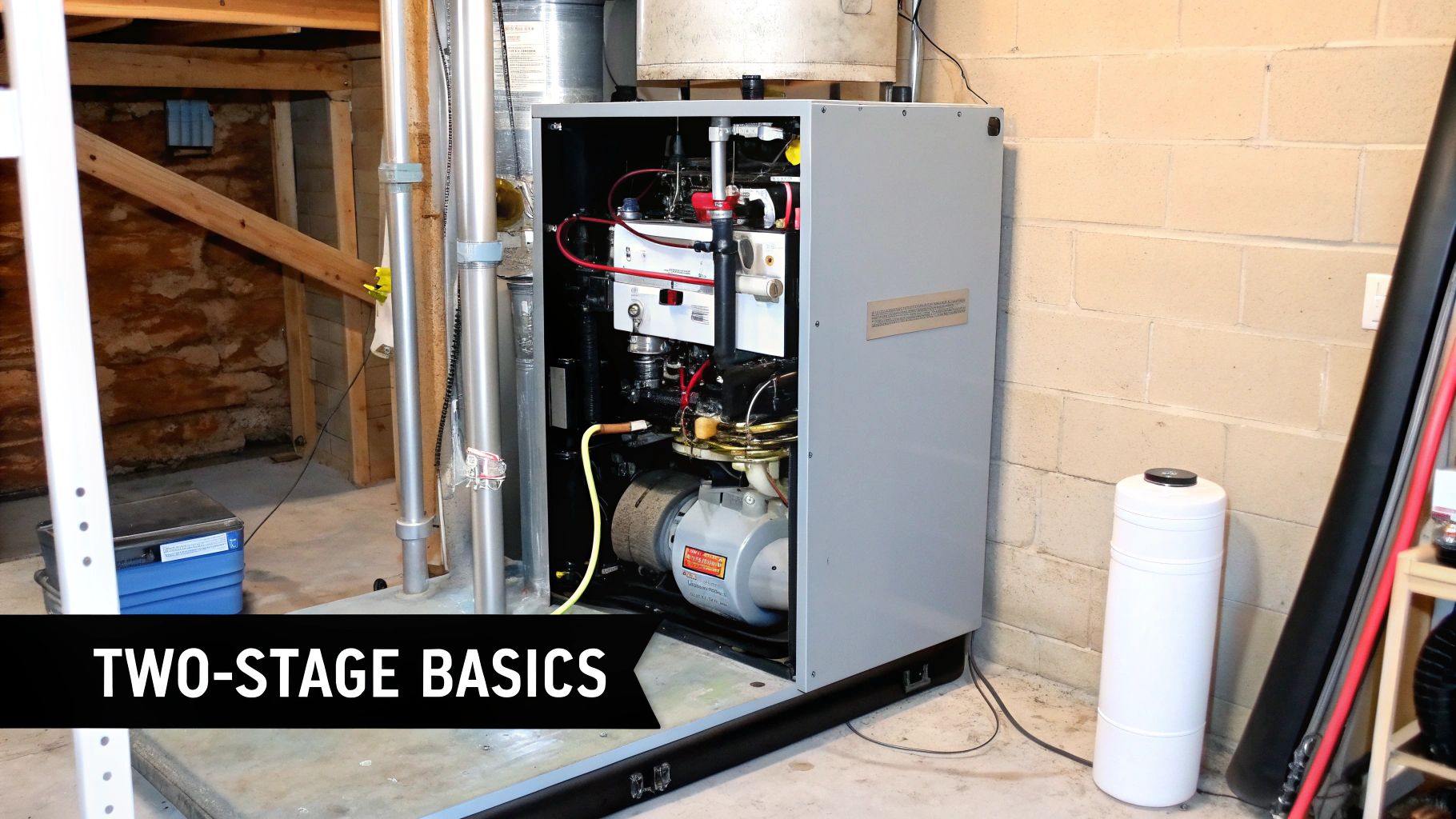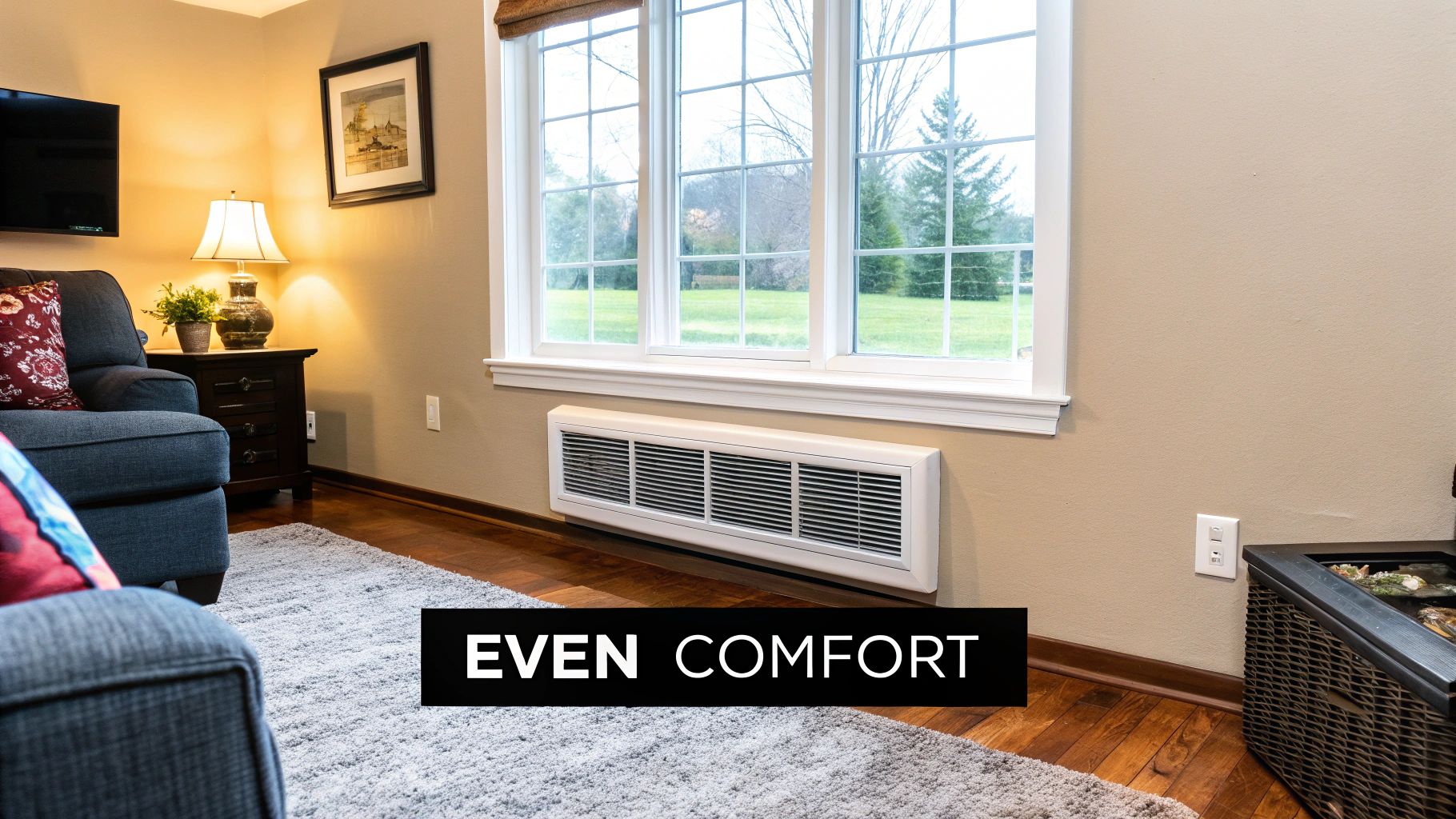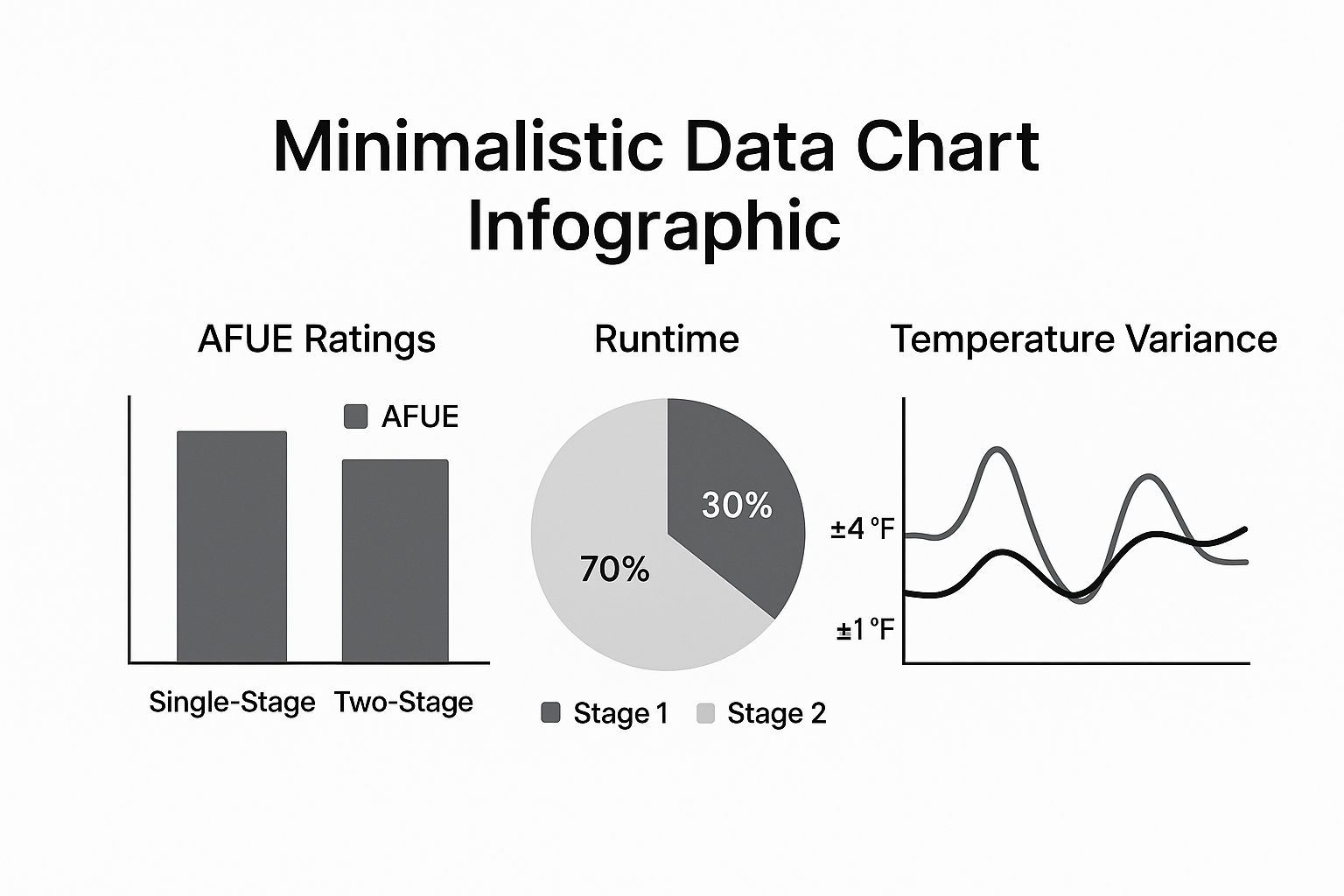What is a Two Stage Furnace? Benefits & How It Works
- shawncovenantaire
- Sep 6
- 9 min read
Updated: Sep 9
A two-stage furnace is a much smarter way to heat your home, giving you two levels of heat instead of just one. It’s less like a simple on/off light switch and more like the gas pedal in your car. It has a low setting for those milder days and a high setting for when the winter cold really bites down, making sure you only use the energy you actually need.
Understanding Two Stage Furnace Technology

To really get what makes a two-stage furnace different, it helps to look at the old way of doing things. A traditional single-stage furnace is an all-or-nothing machine. Every time it kicks on, it’s running at 100% power, no matter if it's just a little chilly or downright freezing outside. This can be pretty wasteful, especially during those mild Tucson winter days.
A two-stage furnace, on the other hand, was built to be more intelligent. The system has two distinct heating levels, high and low, to give you much better control over your home's temperature. It runs at a lower capacity when the weather is mild and only cranks up to full power when a serious blast of heat is required. This gets rid of the jarring temperature swings you often feel with older, single-stage models.
This dual-output system is actually designed to run on its lower, energy-saving setting most of the time, which is usually around 60-70% of its full power. This approach doesn't just keep your indoor temperature more consistent and comfortable; it also seriously boosts your home's overall heating performance. For a deeper dive into system performance, take a look at our guide to HVAC system efficiency.
The real magic of a two-stage system is its adaptability. Instead of blasting your home with maximum heat and then shutting off completely, it delivers a gentle, continuous stream of warmth that finally gets rid of those annoying hot and cold spots.
To help you get a quick visual on how these two types of furnaces operate, here’s a simple breakdown of their core differences.
Comparing Single Stage vs Two Stage Furnace Operation
Feature | Single-Stage Furnace | Two-Stage Furnace |
|---|---|---|
Heat Output | One level: 100% capacity only | Two levels: Low (e.g., 65%) and High (100%) |
Operation | On/Off cycles | Runs longer on low, kicks to high as needed |
Temperature Control | Prone to temperature swings | More consistent, even heating |
Energy Efficiency | Less efficient, especially in mild weather | More efficient, uses less energy on low setting |
Home Comfort | Can create hot and cold spots | Eliminates temperature fluctuations |
As you can see, the two-stage model offers a more nuanced and efficient approach to keeping your home comfortable.
As you dig deeper into furnace technology, it’s also useful to know about their fuel source. To get more insight into natural gas and its different forms, check out this guide on What Is Compressed Natural Gas Explained.
How Your Two Stage Furnace Actually Works

The secret behind a two-stage furnace’s impressive efficiency is its smart, adaptive operation. Unlike an old-school single-stage unit that only has one setting, full blast, a two-stage furnace makes a calculated decision based on what your home actually needs at that moment. This whole process is managed by a smart thermostat, which acts as the brains of the operation.
When your thermostat senses the room temperature has dipped, it signals the furnace to kick on. But here’s the key difference: the system always starts in its first, low-energy stage. In this mode, it runs at roughly 60-70% of its total capacity, producing a gentle, steady stream of heat.
This initial low stage is perfect for handling the mild heating demands we see for most of a typical Tucson winter. The furnace will continue to run quietly and efficiently in this mode, gradually bringing your home up to the perfect temperature without wasting energy.
Shifting Into the Second Stage
So, what happens when that low stage just isn't cutting it against a serious chill? If the smart thermostat detects that the low setting isn't raising the temperature quickly enough, it automatically tells the furnace to shift gears.
That’s when the second, high-power stage kicks in. The furnace ramps up to 100% capacity, delivering the maximum amount of heat possible to warm your home fast. Once you've hit your target temperature, the system will either shut off or, more likely, shift back down to its gentle low stage to maintain that perfect level of comfort.
This two-step process leads to much longer, more consistent heating cycles. It completely avoids those abrupt, noisy blasts of hot air you get with single-stage models, creating a far more stable and comfortable indoor environment.
The core idea behind a two-stage furnace is simple: use only as much energy as you need. By starting low and only escalating to high power when necessary, it conserves fuel and reduces wear and tear on its components.
Understanding how different heating systems perform is key for any Arizona homeowner. To see how furnaces stack up against another popular option, you can explore our detailed guide on the differences between a heat pump vs furnace in Arizona.
The Real Benefits of a Two Stage Heating System

The first thing you'll notice is just how consistent the comfort is. Because the system spends most of its time on that low setting, it gently circulates warm air through your house, finally getting rid of those frustrating hot and cold spots.
No more sudden, loud blasts of heat followed by an uncomfortable chill. Instead, you get a much more stable and even temperature from one room to the next. This steady, gentle operation is what makes a two-stage furnace a game-changer for maintaining a truly comfortable home.
Superior Energy Efficiency and Quieter Operation
Another huge advantage is the boost in energy efficiency. Think about a single-stage furnace: it’s like flooring the gas pedal every time you start your car, only to slam on the brakes moments later. All that stopping and starting at full power wastes a ton of fuel.
A two-stage system is much smarter. It avoids this by running on its lower, more efficient setting about 80% of the time. This intelligent operation can lead to some serious savings on your monthly utility bills. For even more tips on lowering your heating expenses, check out our guide on how to save on your heating bill.
Finally, these furnaces are remarkably quiet. Since the unit runs on its low-power stage most of the time, it produces far less noise than a single-stage model that’s always roaring to life at maximum capacity.
The gentle hum of the low setting is a stark contrast to the loud roar of a traditional furnace kicking on and off. This creates a much more peaceful and pleasant home environment, especially for light sleepers.
Comparing Costs and Performance With Single Stage Furnaces
When it's time to choose a new furnace, the decision often boils down to a classic trade-off: spend less now or save more later. A single-stage furnace is definitely easier on the wallet upfront, but a two-stage model is built from the ground up for efficiency, which can mean serious long-term savings.
Making a confident investment in your home's comfort means understanding what you're really paying for. It’s not just about the price tag on the unit. It’s about how that furnace performs every single day, impacting everything from your monthly utility bills to how long the system will even last.
This infographic really highlights the performance differences you can expect between the two.

As you can see, the two-stage furnace's secret weapon is its ability to run on a lower, energy-sipping setting most of the time. This directly leads to better efficiency and much more even temperatures throughout your home.
A Deeper Look at the Trade-Offs
Let's be honest, initial cost is a huge factor for most homeowners. Single-stage furnaces are simpler machines, which makes them cheaper to build and install. But that simplicity comes at a price. They slam on at 100% capacity every single time they run, which is incredibly wasteful during those milder Tucson days when you just need a little bit of heat.
In contrast, a two-stage furnace might have a higher upfront cost, but its smarter operation starts paying you back immediately. It runs on its lower, energy-saving stage about 80% of the time, burning less fuel and putting far less wear and tear on its parts. This gentle operation can help extend the furnace's lifespan to 15-20 years and cut down on annoying and expensive repair calls.
To get the most out of these savings, it's also critical to make sure your ductwork isn't leaking heated air. You can learn more by checking out our guide to the cost of air duct sealing.
The table below breaks down the key differences to help you see the whole picture.
Detailed Comparison Single Stage vs Two Stage Furnace
When you're trying to decide which furnace is the right fit for your home, laying out the features side-by-side can make the choice much clearer. This table compares the most important aspects of single-stage and two-stage models.
Consideration | Single-Stage Furnace | Two-Stage Furnace |
|---|---|---|
Upfront Cost | Lower initial investment | Higher initial investment |
Operation | Runs at 100% capacity only | Runs at ~70% (low) or 100% (high) capacity |
Energy Efficiency | Less efficient, higher fuel consumption | More efficient, lower fuel consumption |
Temperature Control | Can create noticeable temperature swings | Provides more consistent, even heating |
Noise Level | Louder due to full-power operation | Quieter, as it runs on low stage most of the time |
System Lifespan | Shorter lifespan due to constant full-power strain | Longer lifespan (15-20 years) due to less wear and tear |
Best For | Budget-focused projects, smaller homes in very cold climates | Homeowners prioritizing comfort, efficiency, and long-term savings |
Ultimately, the choice comes down to your priorities. A single-stage furnace offers a lower entry cost, while a two-stage furnace provides a superior experience in terms of comfort, quiet operation, and long-term value.
Is a Two-Stage Furnace the Right Call for Your Home?
Choosing a new furnace is a pretty big deal. It's a major investment, and what's perfect for your neighbor might not be the best fit for you. To figure out if a two-stage furnace makes sense, you have to look beyond the tech specs and think about your specific house, our local climate, and what "comfortable" really means to you.
For homeowners here in Tucson, two-stage systems often hit a sweet spot. Our winters tend to be long and mild, not brutally cold. This is the exact scenario where a two-stage furnace shines, spending most of its time humming along on that gentle, energy-sipping low stage. That steady operation is what finally gets rid of those annoying temperature swings.
Key Factors for Your Decision
Your home’s unique personality plays a huge role in this. For example, a well-insulated house does a great job holding onto heat, which means the furnace's low setting can easily maintain a comfortable temperature without needing to kick into high gear.
As you weigh your options, keep these points in mind:
Our Tucson Climate: Because we deal with more mild-to-cool days than constant deep freezes, a two-stage furnace will operate in its most efficient mode far more often.
Your Home's Insulation: Good insulation lets the low stage do its job properly. It prevents heat from escaping, so the high-power setting is rarely needed.
Personal Sensitivity: Are you the person who always notices a slight draft or the sound of the furnace kicking on? The quieter, more consistent heat from a two-stage model will make a huge difference in your daily comfort.
Home Size: Larger homes, especially two-story ones, really benefit from the even air distribution that comes with longer, gentler run times. This is how you finally eliminate those frustrating hot and cold spots.
A two-stage furnace really proves its worth in a home where the low-power stage can handle most of the heating. It’s an ideal match for anyone who values consistent comfort and long-term energy savings more than a lower sticker price upfront.
Ultimately, making the right choice is all about matching the furnace’s strengths to your home and your lifestyle.
Got Questions About Two-Stage Furnaces? We've Got Answers.
Even after getting the rundown, it’s normal to have a few questions floating around about what a two-stage furnace really means for your home. Let's clear up some of the most common ones so you can feel confident about this smart heating solution.
Does a Two-Stage Furnace Run All the Time?
Nope, it doesn’t run constantly. It does run for longer, steadier cycles than you might be used to with an old single-stage model, but that's a good thing.
The furnace will spend most of its time on that low, quiet setting to gently maintain your home's temperature. This is way more efficient than the loud, abrupt on-and-off blasts from older furnaces. Once it hits your set temperature, it shuts off completely, just like any other furnace.
Can I Use Just Any Thermostat With This Furnace?
To really get all the benefits you’re paying for, you absolutely need a compatible two-stage thermostat. If you try to hook up a standard, single-stage thermostat, you'll force your advanced furnace to act like a basic on/off unit.
Doing that completely defeats the purpose of its energy-saving features. A proper two-stage thermostat is the brain of the operation, telling the furnace when to use the low stage and when to kick into high gear.
A two-stage furnace typically has a lifespan of 15 to 20 years. Because it’s not constantly slamming on at full power, its components see a lot less wear and tear. With proper maintenance, this gentle operation can really extend its working life.
Of course, hitting that 20-year mark depends on regular upkeep. You can find some great tips in our guide to creating your essential HVAC maintenance schedule. A little proactive care goes a long way in keeping your furnace running smoothly for years.
For expert advice on choosing and installing the right furnace for your Tucson home, trust the certified technicians at Covenant Aire Solutions. Contact us today for a no-obligation consultation.


